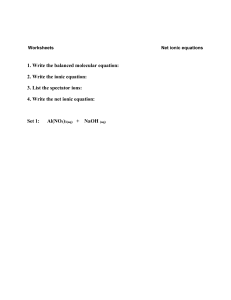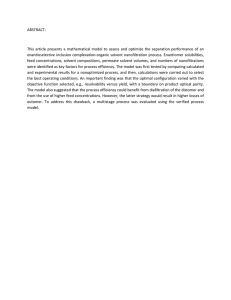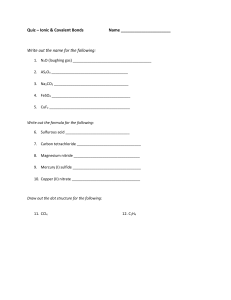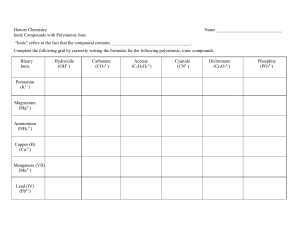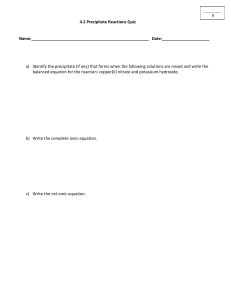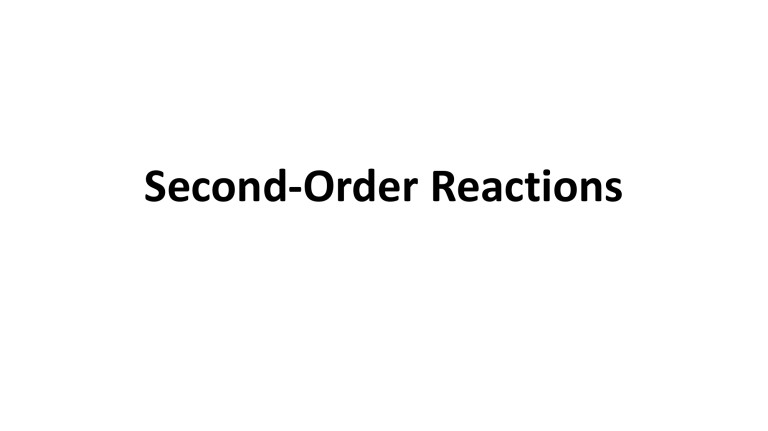
Second-Order Reactions • The rates of bimolecular reactions, which occur when two molecules come together, are frequently described by the second-order equation. A+B Products When the speed of the reaction depends on the concentrations of A and B with each term raised to the first power, the rate of decomposition of A is equal to the rate of decomposition of B, and both are proportional to the product of the concentrations of the reactants: - 𝑑[𝐴] 𝑑𝑡 =- 𝑑[𝐵] 𝑑𝑡 = K [A][B] If a and b are the initial concentrations of A and B respectively, and x is the concentration of each species reacting in time t, the rate law can be integrated and written according to 3 possibilities: 1. When, in the simplest case, both A and B are present in the same concentration so that a = b, 𝑥 𝑎(𝑎−𝑥) = Kt 2. When, in the general case, A and B are not present in equal concentrations but the difference in concentration is not big, integration of equation yields: 2.303 𝑎−𝑏 log 𝑏(𝑎−𝑥) 𝑎(𝑏−𝑥) = Kt The rate constant, k, in a second-order reaction therefore has the dimensions liter/ (mole sec) or liter mole-1 sec-1. The half-life of a second-order reaction is t1/2= 1/ak 3. When A and B are not present in equal concentrations and the difference in concentration is very big (Pseudo-first-order reaction): Suppose that in this reaction, A was in great excess and B was in a relatively low concentration. As the reaction proceeded, B would change appreciably from its original concentration, whereas the concentrations of A would remain essentially unchanged because they are present in great excess. In this case the contribution of A to the rate expression is considered constant and the reaction rate can be written as A+B - 𝑑 [𝐵] 𝑑𝑡 Products = K' [B] where K'= K [A], K'= Pseudo-first-order constant • Factors effects on stability • A number of factors other than concentration may affect the reaction velocity. Among these are temperature, solvents, catalysts, and light. • 1. Temperature effect • Collision Theory • Reaction rates are expected to be proportional to the number of collisions per unit time. Because the number of collisions increases as the temperature increases, the reaction rate is expected to increase with increasing temperature. The effect of temperature on reaction rate is given by the equation, first suggested by Arrhenius, k = Ae-Ea/RT or log K = log A - 𝐸𝑎 1 2.303𝑅 𝑇 where k is the specific reaction rate, A is a constant known as the Arrhenius factor or the frequency factor, Ea is the energy of activation. R is the gas constant, 1.987 calories/deg mole, and T is the absolute temperature. In case at 2 temperatures t1 and t2, the equation becomes: log 𝐾2 𝐾1 = 𝐸𝑎 2.303 𝑅 𝑇2−𝑇1 ( ) 𝑇2𝑇1 Accelerated stability testing The k values for the decomposition of drug at various elevated temperatures are obtained by plotting log of concentration against time as shown in this figure: Then the logarithm of rate constants (k) at various temperatures are plotted against reciprocal of absolute temperature and the resulting line extrapolated to the room temperature to get K25°C as shown in this figure: The shelf life t90% can be calculated from equation t90% = 0.105/ K25°C 2. Medium Effects: Solvent, Ionic Strength, Dielectric Constant a. Effect of the Solvent In summary, it can be said that the polarity of solvents affect the rate of reactions depending on the polarity of reactant. b. Effect of the ionic strength For ionic compound, the ionic strength affects the rate of reaction while for neutral molecule, the rate of reaction independent on ionic strength. • c. Effect of the Dielectric Constant • The dielectric constant affects the rate constant of an ionic reaction. For a reaction between ions of opposite sign, an increase in dielectric constant of the solvent results in a decrease in the rate constant. For ions of like charge, on the other hand, an increase in dielectric constant results in an increase in the rate of the reaction.
